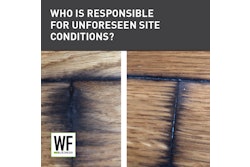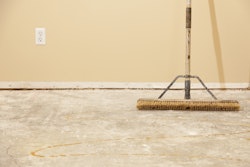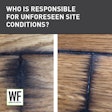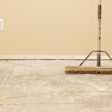
In this industry, installers are often under incredible pressure to get things done as fast as possible. The wood flooring guys are one of the last subs on the job, and time and money are often both short by the time they arrive. That creates a lot of pressure to take shortcuts or ignore industry specs in hopes of creating a happy homeowner or GC. Many guys talk about going ahead with a job as long as the builder or homeowner sign a form to release the installer from responsibility if the floor fails. But will that really protect you from liability? Recently I was on an inspection that ended up being a legal lesson for anyone installing wood floors; here is that story.
I was hired by homeowners who were upset with the flooring installer about the condition of their floors. The homeowners had purchased a value-grade/factory-seconds 3/8-inch locking engineered floor from a retail store. The store does not supply installers, but it gives customers phone numbers to call to hire an installer. The homeowners ended up paying a firm that hires installers.
The installer said that the husband told him he needed the floor installed in two days because they were moving in ASAP. Two workers started the work at 5 p.m. and worked until almost 11 p.m. the following day. As they had removed the carpeting in the home, they had noticed that the concrete subfloor was very wavy and uneven. The installer said he called the husband, who came over to the job site right away. The husband said the furniture movers were coming in two days, and they should proceed with the installation anyway. Once the job was done, the wife was there, and he presented her with a release form to sign. According to the installer, this was the standard release he uses when installing value-grade flooring with face defects, and it also spelled out the problems with the subfloor on the job. He said there were no installation instructions in the box, and it was a value-grade floor anyway.
After installation, the homeowner complained that the floor was buckling, and many end joints in the floor were broken and moving up and down. The retailer said all its floors are sold with no guarantees or warranties, and the installer said he had no liability for the floor since he had a signed release.
When I visited the site, there were areas of the floor that had risen 3 to 6 inches off the subfloor. The "bubble" effect was approximately 4 feet in diameter in one area and there were two similar but slightly smaller areas. They would go down when I walked on them and rise again when I walked away. I came back to the job site at the time the flooring was being removed and the new floor was to be installed. I measured the subfloor and found up to a 3-inch dip in some areas and as much as 1½-inch humps in others. (The homeowners had found the installation instructions for this floor on the Internet; the instructions detailed that a maximum of a 316-inch difference was allowable in a 10-foot span.)
Not surprisingly, this case ended up in court, where I was a witness. The installer and the firm that had hired the installer had a lawyer present; the homeowner represented himself. I had to testify concerning the photos I took, the installation instructions and NWFA standards. The installer presented the release that the wife had signed. The wife claimed that she did not know what she was signing; the installer said he had explained it to the husband before starting work and then again explained it to the wife before she signed the release.
The homeowner had paid approximately $4,000 for the flooring and installation but still owed about $2,000 to the firm hiring the installer, who hadn't been paid anything. The homeowners presented an estimate of $16,000 to remove the old floor, repair the subfloor and have new and better-grade flooring installed, along with new trim and the removal/storage of the furniture.
The ruling? The judge said that the homeowners were not experts in flooring; rather, they had hired a flooring installer who was the expert. The installation instructions clearly stated that the subfloor needed to be flat within 316 inch over a 10-foot span. He ruled that the installer should pay $8,000 in damages and that the firm hiring the installers should also pay $8,000. The homeowner did not ever have to pay the $2,000 still owed to the installer. So, for a $2,000 job, the installer ended up being out $10,000.
The installer said he would have to go out of business if he lost the case, but that didn't matter. The judge emphasized that no matter what the owners said, signed or authorized, it was the flooring installer who should have done the job the right way or walked away.
Read about another contractor's experience when she goes to small claims court here.
Business Briefs
To-Dos for Tough Times

- Look toward the future. Ask your employees what skills or training you can give them to better do their jobs.
- Have efficient systems in place. If team members don't fully understand how to get things done and do it well, morale will go down.
- Hold regular staff meetings. They improve communication, goal setting and accountability.
- Be a good leader. Employees want leaders who are fair, consistent and apply the same policies to everyone.
- Promote a positive work environment. If you have a positive attitude, employees will mirror that.
- Do things with your team outside work. This improves morale and encourages friendship between employees.
Dr. Rhonda Savage is an internationally acclaimed speaker and CEO for a well-known practice management and consulting business. For more information, visit www.DentalManagementU.com or e-mail [email protected].
































